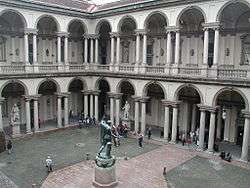Biblioteca di Brera

The Biblioteca Nazionale Braidense or Braidense National Library, usually known as the Biblioteca di Brera, is a public library in Milan, in northern Italy. It is one of the largest libraries in Italy. Initially it contained large historical and scientific collections before it was charged with the legal deposit of all publications from Milan. Since 1880, it has had the status of a national library and is today one of the 47 Italian State libraries.[1]
History
The library was created in 1770 by Maria Theresa of Austria when she decided to make the collection she had acquired from Carlo Pertusati available to the public. The library was opened in 1786 in the Brera Palazzo del Collegio which had been taken over by the State following the dissolution of the Society of Jesus in 1773. In addition to the Pertusati collection, the library also contained the holdings of the Collegio Braidense and of the Jesuit houses of San Fedele and San Girolamo.[2]
Thereafter the library benefitted from various private collections and from the libraries of other religious orders which had been dissolved as well as duplicates from the Imperial Library in Vienna. From 1788, the collection was enhanced by adding publications received under legal deposit regulations which covered works published in the State of Milan. As a result, the Braidense became the regional legal deposit archive for Lombardy.[3]
In 1880, the Braidense was given the status of national library.
The premises

The library is located in the Palazzo di Brera, an imposing building constructed by the Jesuits in the 17th century. In addition to the library, it is also home to the Brera Art Gallery, the Brera Astronomical Observatory, the Brera Botanical Gardens, the Lombard Institute of Science and Letters and the Brera Academy of Fine Arts. Since 2003, it has also housed the Archivio Storico Ricordi, the historical records of the Ricordi classical music publishing company.
Among the library's facilities are the Maria Teresa Hall with bookshelves designed by the architect Giuseppe Piermarini, the Reading Room which was originally used by the Jesuits, the Research Reading Room with some 35,000 books, the Sala Manzoniana with manuscripts, correspondence and editions of the Italian romantic writer Alessandro Manzoni and the Catalogue Room, formerly the tailors' room in the Palazzo di Brera.[1]
The collections
Since the beginning, the Braidense was designed as a general library. The collections consisted of illuminated choral works, historical, literary, theological and legal publications as well as extensive general reference works.
During the 19th and 20th centuries, the library was enhanced with many other holdings. In 1778, it acquired the collection of Swiss bibliophile Albrecht von Haller covering botanical and medical works and, in 1795, a legacy from Cardinal Angelo Maria Durini containing some 3,000 works including valuable 16th century Greek and Latin editions.[4]
The Braidsense has always has the dual role of both the preservation of historical and literary works and of maintaining its collection of all books published in Milan. It currently has 898,377 printed volumes, 2,119 manuscripts and 2,368 incunabula.[5]
See also
- Neoclassical architecture in Milan
- National Central Library (Florence)
- Biblioteca Nazionale Centrale di Roma
- Biblioteca Nazionale Vittorio Emanuele III
- Turin National University Library
- Biblioteca Nazionale Marciana
| Wikimedia Commons has media related to Biblioteca di Brera (Milan). |
References
- 1 2 "Biblioteca Nazionale Braidense", www.braidense.it. Retrieved 5 September 2012.
- ↑ Amedeo Benedetti and Bruno Benedetti, Gli archivi della Scienza. Musei e Biblioteche della Scienza e della Tecnologia in Italia, Genova, Erga, 2003, p. 85. (Italian)
- ↑ "Beni librari - Circolare sul deposito legale", 31 December 2008, LombardiaCultura. (Italian)
- ↑ La Biblioteca nazionale Braidense, "Biblioteche Oggi", Milano, Ed. Bibliografica, n. 8, October 2008, p. 16. (Italian)
- ↑ Ministero dei Beni e delle Attività culturali - Ufficio Statistica (Italian)
Bibliography
- Aurelio Aghemo, La Biblioteca nazionale Braidense, "Biblioteche Oggi", Milan, Ed. Bibliografica, n. 8, October 2008, pp. 15–20.
Coordinates: 45°28′18.84″N 9°11′15.89″E / 45.4719000°N 9.1877472°E